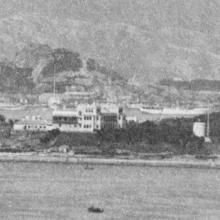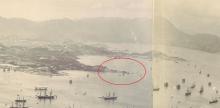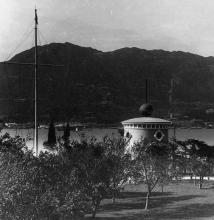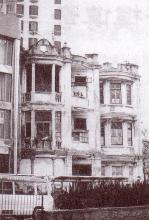Former Marine Police HQ [1884- ]
Primary tabs
Submitted by philk on Mon, 2008-10-20 09:18
Current condition:
In use
Date Place completed:
1884-09-19
Currently being turned into a boutique hotel called 1881 Heritage. This is a protected monument.





Comments
Recent photo
Former Marine Police HQ
The pizza oven
Pete, you beat me to it! I had just got the photo ready to post, when I saw your message.
It's on Canton Road, near to the junction with Salisbury Road:
The pizza oven
water police
Water Police
Water Police Boundary Stone
After the Marine Police HQ at TST closed down, the Water Police Boundary Stone that stood outside the front entrance was removed to the Marine Police Base at Sai Wan Ho.
Early view of the time ball
Redevelopment of the Marine Police HQ
Some old photos show a smaller, but more ornate building on the site. Then in the 1880s the larger, present building appears. I'm curious to learn more about the older building, and the transition from old to new.
Here are a few notes I've found on the subject. First in the Hong Kong Government Gazette:
Then in the 1884-09-20 edition of the China Mail, page 3, is an announcement of its opening:
The new Police Station at Tsim Tsa Tsoi [sic.], opened yesterday, will afford the residents of Kowloon a greater measure of protection than they have hitherto enjoyed. A strong body of Police could be despatched from the Station to any spot in the Peninsula in a very short space of time in a case of emergency.
Although the article doesn't say it is the Water Police, I think it's the same building they're describing.
Marine Police HQ
The original Water Police Station in TST was constructed in the mid-1860s and was superceded by the existing building, first occupied on 19 September 1884. It was originally a two-storey building and a third floor was added in 1920. Although housing the Water Police, it was also responsible for policing in the south of Kowloon, a situation which continued until the completion of a new TST Police Station in 1984.
re: Marine Police HQ
Thanks Mike. I've added in your opening date for this Place, and made a new one for the original Water Police Station.
Regards, David
The Marine Police HQ in the 1950s-70s
Thanks to Charles Ng, who writes:
West Wing (upper floors)
In the 1950s, the first and second floors of the West Wing of the main building were reserved as quarters for the Second in Command of the Marine Division.
At that time there were only 3 Major Police Districts in the Hong Kong Police Force: they were The Kowloon District; The Hong Kong Island District; and The New Territories and Marine District, each of which was under the command of an Assistant Commissioner of Police (ACP). The Marine Police was then only a Division headed by a Superintendent but under the jurisdiction and command of the ACP/NT & Marine. The Second in Command of the Marine Division was a specialist Chief Inspector (CI/Marine), who was not a career Police Officer.
It was after the late 1960s when Marine expanded that the Division was upgraded to a Police District and separated its command from the NT Police District. The Post of the Commander of Marine Police District was upgraded to ACP and his 2 I/c SSP. Consequently the reserved quarters for CI/marine on the West Wing were transferred to the general quarter pool for the Inspectorate. They were allocated to me in 1972 and my family lived there until 1977, when I was directed by Headquarters to move out to make way for the quarters to be converted to offices because of their shortage in the building.
West Wing (ground floor) and East Wing
As Marine Headquarters was sharing the building with Tsim Sha Tsui Police Station. The Report Room of TST Police Station occupied the ground floor of the West Wing, and the barrack rooms of its Rank & File (R & F) were at the other side of the East Wing on the hill.
Barracks for Marine Rank & File
In the 1950s, Marine Police was only a small division having a strength of fewer than 300 personnel. Only 300 numbers were given to the Marine Rank and File from 3401 to 3700, apart from some civilian wireless operators, engineers and stokers who worked on the launches and Headquarters. These R & F were housed in the barrack rooms down at the bottom the hill on the East side of the main building at Ashley Road.
It was after Marine expansion, additional barrack rooms were constructed on the front lawn between the main building and the tower.
Marine Police fleet
The Marine Police fleet was also comparatively small in the 1950s. You can count them on the fingers of both your hands:
It was only in the mid-1950s that 6 more 70-foot launches were ordered to be constructed by Choy Lee Shipyard to add to the fleet; then later in the 1970s with the influx of the Vietnamese refugees into Hong Kong that Marine Police had expanded into its present strength.
Marine Police uniforms
Originally, Marine Police wore different uniform from the regular Land Police, a kind of sailor styled uniform very similar to that worn by British Royal Navy. The uniform was only changed following its upgrading to a Police District to coincide with its Land counterpart.
The new building in 1884
From page 3 of The China Mail, 1884-09-20:
The New Water Police Station.
Yesterday morning the members composing the water contingent of the Police Force removed from their temporary and uncomfortable quarters in Crosby’s Store, on the Praya, to the new, handsome, commodious and comfortable Station at Tsim Tsa Tsoi, just completed. This work, started some three years ago, has been much delayed in being finished, owing to the great pressure of work on the Surveyor General's Department and also the dilatoriness of the contractor. The building occupies one of the most commanding positions in the Colony, and possesses an uninterrupted and magnificent view of every part of the Harbour and also the Kowloon Peninsula. Its site has been well chosen, and should answer all the purposes for which the building is required. Situate on the summit of the hillock almost directly above the landing stage at Tsim Tsa Tsoi ferry, the building, graceful and even palatial in appearance, can be observed from all points of the harbour and should easily be reached by those in want of assistance. As a place of residence for the force it is immensely superior to any floating home. In the old hulk, mow no more, the men were cribbed and cabined in a very disagreeable manner. They suffered both in health and spirits. When off duty they had little chance of relaxation, owing to the difficulty of getting ashore and back, and the accommodation provided was woefully inadequate. Their new quarters are, it seems to me, in every way suitable, both as to accommodation and salubrity. Of course, it has yet to be proved whether they are healthy or otherwise, but a more promising site could hardly have been selected. If there be a breeze blowing at all, the occupants of the building are bound to get the advantage of it, and with the thorough and complete system of ventilation which has been introduced into the building, it should always be cool, even in the hottest weather.
The shape of the structure is that of a quadrangle, in the centre of which is an open court of about 90 feet square. The front elevation is to the South, and this is at once elegant and substantial. At the S. W. and S. E. corners are towers of three stories in height each, and between these is the main building, less ornamental than the towers about 90 feet in length. Verandahs, seven feet wide, run along the front of the main building. These are supported by rubbed granite columns, which have a very pretty effect. Entering by the door at the S. W. corner the first apartment met with is the Charge Room, a spacious apartment, but at present unfurnished. Here will be placed the telegraph instrument. Adjoining the Charge Room is a small but convenient room for the use of the interpreter. Continuing inwards we come to the Europeans' mess room, a big and airy room. Just behind this room are the cells, three in number. Each cell is 6 feet long by 10 feet wide and 14 feet high, and are well ventilated by means of iron gratings. They are all fitted with iron grated doors inside and wooden doors outside. The floor is made of cement concrete. All the other floors throughout the buildings are composed of teak wood. At the end of the passage leading from the S. W. entrance is a stone staircase, beneath which is a small cellar which is to be used as a magazine for ammunition, etc. Ascending this stair, we reach the European Sergeants’ room, 20 feet square, in which will be accommodated 4 men. Next is a room, 34 foot by 20 feet, meant to accomodate eight Europeans. Further in is the Inspector’s sitting room, 24 feet square. Above this is his bedroom, and another sitting room, as well as a bath room and other conveniences. All these rooms are in the West Tower.
The rooms, both on the ground and first floors, are all of one size, 30 feet by 24 feet, and number ten. One of these rooms will be reserved for eight Europeans, and all the others will bo inhabited by 16 Chinese each. The fittings in all these rooms are of the usual barrack style, a bed and shelf being provided for each man, iron bedsteads for the Europeans, and planks with mats for the Chinese.
Running along the back is a wide, closed-in verandah.
The Eastern Tower is reserved almost exclusively for the use of the Captain Superintendent of Police. On the ground floor is an office and boy’s room; on the first floor are a drawing room and dining room, and on the second floor are two bedrooms, a bath room, &c., A separate and private entrance to the Captain Superintendent's quarter is provided on the eastern side of the Tower. The only other rooms in this Tower are a store room on the ground floor and a room for 12 Chinese sergeants on the North East end of the first floor.
The windows and doors, all supplied with double bolts, throughout the entire building are numerous, and there is an abundance of both light and air everywhere.
Below the Eastern Tower is an underground passage communicating with the cookhouse and coolies’ quarters attached to the Captain Superintendent’s establishment. These are divided off from the other out-houses of the Station, and have, like the house itself, a separate entrance on the East. There are also underground passages running under the floors of the whole building, by means of which the floors can easily be examined for white ants.
The out-house accommodation provided is of a very adequate and excellent description, and include bathrooms and cookhouses for Inspectors, Europeans and natives, and coolies’ quarters. This is the first time the native policemen have been provided with proper bathhouse accommodation and it is to be hoped they will take full advantage of it.
In the centre of the open court is a sunken water tank, capable of holding 60,000 gallons of water, and attached to it is a force pump for forcing the water into the various bathrooms tanks, etc. The water supply is composed of what rain is caught on the roofs and also from a well on the North Eastern side of the Station. A force pump sends the water from this well into the tank. The water is of an excellent quality, and as the drainage has received the most careful attention and consideration there is little fear of its being contaminated on that account.
Vanes are attached to the four turrets of the towers, and these are also supplied with lightning conductors.
An excellent road runs from the Station to the Kowloon Praya, where a small dock, or basin, for the accommodation of launches and boats is under construction. A small draw-bridge is to span the entrance to this basin. It will be some time yet before it is completed.
The building and accessories reflect credit on both designer and executors. Mr G Baynes, the overseer of works, has seen the work carried out in a most efficient manner.
Inspector Cradock, the oldest, and one of the most experienced officers in the Police Force, who has been in charge of the water police for some time past, entered into the occupancy of the new quarters yesterday.